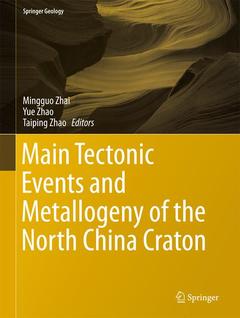Description
Main Tectonic Events and Metallogeny of the North China Craton, 1st ed. 2016
Springer Geology Series
Coordinators: Zhai Mingguo, Zhao Yue, Zhao Taiping
Language: English
Support: Print on demand
Description
/li>Contents
/li>Biography
/li>Comment
/li>
Corresponding main metallogenic epochs to key geological events in the North China Craton: an example for secular changes in the evolving Earth.- Archean continental crust in the southern North China Craton.- Structural architecture and spatial-temporal distribution of the Archean domains in the Eastern North China craton.- Formation ages and environments of Early Precambrian banded iron formation in the North China Craton.- Neoarchean banded iron formations in the North China Craton: geology, geochemistry and its implications.- Archean continental crustal accretion and banded iron formations, Southeastern North China Craton.- Paleoproterozoic gneissic granites in the Liaoji mobile belt, North China Craton: implications for tectonic setting.- Genetic mechanism and metamorphic evolution of Khondalite series within the Paleoproterozoic mobile belts, North China Craton.- Paleoproterozoic copper system in the Zhongtiaoshan region, southern marginof the North China Craton: ore geology, fluid inclusion, and isotopic investigation.- The Paleoproterozoic continental evolution in the southern North China Craton: Constrains from magmatism and sedimentation.- The Great Oxidation Event and its records in North China Craton.- Early Paleoproterozoic metallogenic explosion in North China Craton.- A genetic link between Paleoproterozoic Yuanjiacun BIF and the Great Oxidation Event in North China Craton.- Magmatic records of the late Paleoproterozoic to Neoproterozoic extensional and rifting events in the North China Craton: a preliminary review.- Meso-Neoproterozoic stratigraphic and tectonic framework of the North China Craton.- Petrogenesis and tectonic significance of the late Paleoproterozoic to early Mesoproterozoic (~1.80-1.53 Ga) A-type granites in the southern margin of the North China Craton.- Insights into the ore genesis of the giant Bayan Obo REE-Nb-Fe deposit and the Mesoproterozoic riftingevents in the northern North China Craton.- Paleozoic to early Mesozoic tectonics of North China Craton.- Two-stage extensional pattern in the North China-Mongolian tract during late Mesozoic: insights from the spatial and temporal distribution of magmatic domes and metamorphic core complexes.- Mesozoic Mo deposits in northern North China Craton.- Late Mesozoic gold mineralization in the North China Craton.- Lower crustal accretion and reworking beneath the North China Craton: Evidences from granulite xenoliths.
Mingguo Zhai is a Research Professor at the Institute of Geology and Geophysics, Chinese Academy of Sciences; a Professor at Northwest University (China); a Guest Professor at the University of Chinese Academy of Sciences and Jilin University, and a Visiting chair professor at Sun Yat-Sen University. He received his B.Sc. (1976) from Northwest University (China), and his M.Sc. (1982) and Ph.D. (1989) from the Chinese Academy of Sciences. He was elected member of the Chinese Academy of Sciences (Academician) in 2009. His professional fields cover Precambrian geology, metamorphic geology and petrology. His research focus is on early crustal evolution, continental geodynamics and metallogeny.
Yue Zhao is a Research Professor and Vice-Director of the Institute of Geomechanics, Chinese Academy of Geological Sciences, Beijing. He earned a bachelor's degree in geology from Changchun College of Geology in 1982 and a MS degree in structural geology and tectonics from the Chinese Academy of Geological Sciences in 1986. His research interests include structural and tectonic evolution of East Asian and the East Antractica. He firstly propopsed that the Jurassic deformations in northern North China Craton is related to geotectonics transition from Paleoasian system and Paleotethyan system to Paleopacific active continental margin of eastern Asia. He is also the first one explained the meaning of the Pan-African events in Prydz Bay, East Antarctica and its inference on East Gondwana tectonics.
Taiping Zhao is a Research Professor at the Guangzhou Institute of Geochemistry, Chinese Academy of Sciences. His research interests include magmatism and related ore-forming processes. He has been focused on the study of the igneous rocks and related ore deposits in North China Craton and East Qinling-Dabie orogenic belt in the last two decades. His current researches mainly consist of two aspects, major Precambrian geological events a



